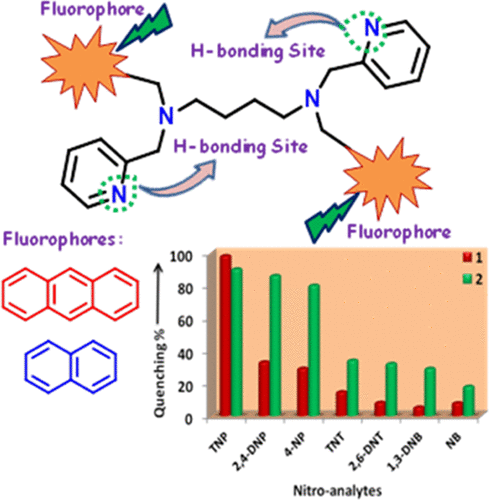Our official English website, www.x-mol.net, welcomes your
feedback! (Note: you will need to create a separate account there.)
Design and Development of Fluorescent Sensors with Mixed Aromatic Bicyclic Fused Rings and Pyridyl Groups: Solid Mediated Selective Detection of 2,4,6-Trinitrophenol in Water.
ACS Omega ( IF 3.7 ) Pub Date : 2018-03-19 , DOI: 10.1021/acsomega.8b00080 Gouri Chakraborty 1 , Sanjay K Mandal 1
ACS Omega ( IF 3.7 ) Pub Date : 2018-03-19 , DOI: 10.1021/acsomega.8b00080 Gouri Chakraborty 1 , Sanjay K Mandal 1
Affiliation

|
For a strategic incorporation of both π-electron-rich moieties and Lewis basic moieties acting as hydrogen bonding recognition sites in the same molecule, two new fluorescent sensors, N,N'-bis(anthracen-9-ylmethyl)-N,N'-bis(pyridin-2-ylmethyl)butane-1,4-diamine (banthbpbn, 1) and N,N'-bis(naphthalen-1-ylmethyl)-N,N'-bis(pyridin-2-ylmethyl)butane-1,4-diamine (bnaphbpbn, 2), have been developed for the selective detection of highly explosive 2,4,6-trinitrophenol (TNP) in water. Each of the two identical ends of these sensors that are linked with a flexible tetra-methylene spacer contains a mixed aromatic bicyclic fused ring (anthracene or naphthalene) and a pyridyl group. These are synthesized via the simple reduced Schiff base chemistry, followed by the nucleophilic substitution reaction under basic conditions in high yields. Both 1 and 2 were characterized by Fourier transform infrared, UV-vis, and NMR (1H and 13C) spectroscopy, and high-resolution mass spectrometry. The bulk phase purity of 1 and 2 and their stability in water were confirmed by powder X-ray diffraction (PXRD). Utilizing the effect of solvents on their emission spectra as determined by fluorescence spectroscopy, spectral responses for 1 and 2 toward various nitro explosives were recorded to determine a detection limit of 0.6 and 1.6 ppm, respectively, for TNP in water via the "turn-off" quenching response. Also, the detailed mechanistic investigation for their mode of action through spectral overlap, lifetime measurements, Stern-Volmer plots, and density functional theory calculations reveals that resonance energy transfer and photoinduced electron transfer processes, and electrostatic interactions are the key aspects for the turn-off response toward TNP by 1 and 2. In addition, the selectivity for TNP has been found to be more in 1 compared to 2. Both exhibit good recyclability and stability after sensing experiments, which is confirmed by PXRD and field-emission scanning electron microscopy.
中文翻译:

具有混合芳香双环稠环和吡啶基的荧光传感器的设计和开发:固体介导的水中2,4,6-三硝基苯酚的选择性检测。
为了将富含π电子的部分和充当基本氢键识别位点的Lewis基本部分进行战略合并,两个新的荧光传感器N,N'-双(蒽-9-基甲基)-N,N' -双(吡啶-2-基甲基)丁烷-1,4-二胺(banthbpbn,1)和N,N'-双(萘-1-基甲基)-N,N'-双(吡啶-2-基甲基)丁烷-1,4-二胺(bnaphbpbn,2)已开发用于选择性检测水中的高爆炸性2,4,6-三硝基苯酚(TNP)。这些传感器的两个相同末端均与柔性四亚甲基间隔基连接,每个末端均包含一个混合的芳香族双环稠环(蒽或萘)和一个吡啶基。这些是通过简单的还原席夫碱化学方法合成的,然后在碱性条件下以高收率进行亲核取代反应。1和2均通过傅立叶变换红外光谱,紫外可见光谱和NMR(1H和13C)光谱以及高分辨率质谱进行表征。通过粉末X射线衍射(PXRD)证实了1和2的本体相纯度及其在水中的稳定性。利用荧光光谱法确定的溶剂对其发射光谱的影响,记录1和2对各种硝基炸药的光谱响应,通过“关闭”来确定水中TNP的检出限分别为0.6和1.6 ppm。淬灭反应。此外,通过光谱重叠,寿命测量,斯特恩-沃尔默图和密度泛函理论计算对它们的作用方式进行的详细机械研究也表明,共振能量转移和光致电子转移过程,
更新日期:2018-03-19
中文翻译:

具有混合芳香双环稠环和吡啶基的荧光传感器的设计和开发:固体介导的水中2,4,6-三硝基苯酚的选择性检测。
为了将富含π电子的部分和充当基本氢键识别位点的Lewis基本部分进行战略合并,两个新的荧光传感器N,N'-双(蒽-9-基甲基)-N,N' -双(吡啶-2-基甲基)丁烷-1,4-二胺(banthbpbn,1)和N,N'-双(萘-1-基甲基)-N,N'-双(吡啶-2-基甲基)丁烷-1,4-二胺(bnaphbpbn,2)已开发用于选择性检测水中的高爆炸性2,4,6-三硝基苯酚(TNP)。这些传感器的两个相同末端均与柔性四亚甲基间隔基连接,每个末端均包含一个混合的芳香族双环稠环(蒽或萘)和一个吡啶基。这些是通过简单的还原席夫碱化学方法合成的,然后在碱性条件下以高收率进行亲核取代反应。1和2均通过傅立叶变换红外光谱,紫外可见光谱和NMR(1H和13C)光谱以及高分辨率质谱进行表征。通过粉末X射线衍射(PXRD)证实了1和2的本体相纯度及其在水中的稳定性。利用荧光光谱法确定的溶剂对其发射光谱的影响,记录1和2对各种硝基炸药的光谱响应,通过“关闭”来确定水中TNP的检出限分别为0.6和1.6 ppm。淬灭反应。此外,通过光谱重叠,寿命测量,斯特恩-沃尔默图和密度泛函理论计算对它们的作用方式进行的详细机械研究也表明,共振能量转移和光致电子转移过程,











































 京公网安备 11010802027423号
京公网安备 11010802027423号